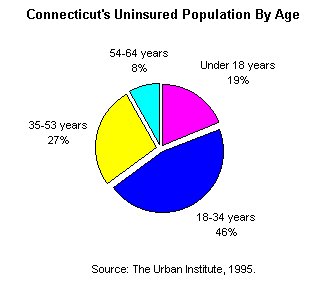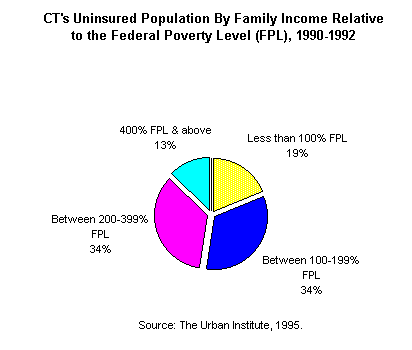
High and Still Rising Costs
The cost of medical care has been growing rapidly for years. Even though these increases have slowed somewhat in the 1990s, health care spending is still rising much faster than the general rate of inflation. In 1970, according to the Congressional Budget Office (CBO), the United States spent $74.4 billion on health care. By 1990, that figure had risen to $675 billion and in 1995 national health expenditures are expected to exceed $1 trillion.
In Connecticut, health care costs have consistently been among the highest in the nation, while its health care spending trends matched the national experience. In 1980, total health care spending for all Connecticut residents was slightly less than $4 billion. In 1991, that figure had risen to $12.7 billion and by the year 2000 Connecticut health spending is projected to reach $24.1 billion dollars. (click here to see footnote). When these figures are divided to obtain per capita spending estimates, Connecticut ranks among the most expensive states in the nation.
Increases in the cost of health insurance and medical care have hurt the standard of living for most Connecticut workers. In the past, many workers thought of their health insurance coverage as "free," that is, a fringe benefit that did not cost them anything. Employers, on the other hand, have always counted this cost as part of overall compensation. From the employer's perspective, as health benefit costs rise so does the total level of compensation to the employees - - even if cash wages remain stagnant. As a result, many Connecticut workers have seen slower growth or no growth in real wages, an erosion of health benefits, increased cost sharing for health care, or some combination of all three.
Employers in Connecticut and across the nation have also felt the effects of rapidly rising health costs. Over the past three decades, health expenses have taken a much more significant portion of employers' operating expenses. In 1965, for example, health insurance expenses represented only 2% of the total compensation paid by U.S. employers, while in 1990 that figure rose to 7.1%. Likewise, in 1965, health insurance accounted for 22% of fringe benefit costs, compared with 45% in 1990. (click here to see footnote).
Erosion of Employer-Based Coverage
Rising health costs and the general state of the economy have eroded employer-based health coverage in Connecticut and contributed to the problem of uncompensated care. If people lose their jobs, chances are they will lose their health insurance as well. Moreover, as the cost of health insurance rises, fewer employers can afford to provide coverage for their workers and smaller businesses are especially at risk. Large firms generally wield more negotiating power over insurers and benefit by spreading risk and administrative expenses over a larger pool of employees. In doing so, they have been more successful in controlling their health care expenses. Unfortunately, insurers sometimes make up for this by shifting the costs onto smaller employers, who are generally in a much weaker bargaining position. As a result, these small firms are more likely to get priced out of the health insurance market.
The Uninsured: A Growing Problem
Lack of health insurance coverage is a problem for millions of Americans. In 1992, 17% of Americans under age 65 were without insurance, representing over 37 million people. Virtually all Americans lacking health insurance are under age 65 because Medicare provides coverage for nearly all elderly citizens as well as the most severely disabled. Most non-elderly Americans obtain private health insurance coverage through their employers (about 60%) or purchase it themselves (about 9%). Medicaid covers those on welfare and some related low-income groups, providing health insurance to 12% of the non-elderly population. Another 2% are covered by other public programs. Uninsured Americans either fall through the cracks of the employment- based system or do not meet the restrictive income and categorical requirements for Medicaid assistance.
Lack of health insurance has been a growing problem for Connecticut in recent years as well. The percentage of non-elderly uninsured state residents has risen from 8.5% in 1990 to 12.1% (about 340,000) in 1993, according to estimates by the Employee Benefit Research Institute.

Who Are the Uninsured?
One available source for demographic information on the uninsured comes from the Current Population Survey (CPS), which is conducted each March by the US Bureau of the Census. Nationwide, nearly 60,000 households are interviewed on a variety of topics, including health insurance coverage. Due to the size of the sample, health care analysts tend to merge 3 years worth of data so that meaningful conclusions can be drawn on the state level. A recent publication by the Urban Institute used this approach to provide a state-by- state demographic profile of the uninsured. The merged CPS data covers 1990-1992 and is the most recent available.
The data shows that Connecticut's uninsured are a diverse group; they come from different income levels, age groups, and family types. Significantly, the vast majority of the uninsured are from working families. More than 7 in 10 uninsured households in Connecticut have at least one adult who works full-time and another 15% have at least one adult who works part-time. Only 12% of uninsured households are headed by adults who are not in the work force.

In addition, the uninsured are much more likely to work for small and medium size firms. Fifty-two percent of Connecticut's uninsured workers are employed by firms with less than 25 employees. Another 13% work for firms with between 25 and 99 employees. The rest (35%) are employed by firms with more than 100 workers.

Again, reflecting the dominance of working families among the uninsured, the vast majority of Connecticut's uninsured population (81%) fall between the ages of 18 and 64, while the remaining 19% are children.

Nineteen percent of Connecticut's uninsured are poor, living under the federal poverty level (FPL). By way of illustration: an individual earning $7,400 per year, a couple earning $10,000 per year, and a family of three earning $12,500 per year would all fall into this category. Another 34% of the uninsured are considered near-poor, living between 100 and 199% of the FPL. Middle income families, those between 200% and 399% of the FPL, make up 35% of the uninsured. The remaining 13% come from higher income families, those at 400% of the FPL or above. The chart below presents these annual income levels as a percentage of the 1995 federal poverty guidelines.

| Annual Income Levels as a Percentage of the 1995 Federal Poverty Guidelines |
||||
|---|---|---|---|---|
| Number in Family |
Poverty Level (100% of FPL) |
Near Poor (200% of FPL) |
Middle Income (300% of FPL |
Higher Income (400% of FPL |
| 1 | $ 7,470 | $14,940 | $22,140 | $29,880 |
| 2 | $10,030 | $20,060 | $30,090 | $40,120 |
| 3 | $12,590 | $25,180 | $37,770 | $50,360 |
| 4 | $15,150 | $30,300 | $45,450 | $60,600 |
| 5 | $17,710 | $35,420 | $53,130 | $70,840 |
| 6 | $20,270 | $40,540 | $60,810 | $81,080 |
| 7 | $22,830 | $45,660 | $68,490 | $91,320 |
| 8 | $25,390 | $50,780 | $76,170 | $101,560 |
| For each additional member add |
$2,560 | $5,120 | $7,680 | $10,240 |
Why Lack of Insurance Matters
Lack of health insurance matters not only to uninsured individuals and families, but also to society as a whole. For individuals and families health insurance affects job decisions, financial security, access to care, and health status. Lack of insurance and gaps in coverage have an impact on everyone--not just the uninsured. When an uninsured person goes to a hospital, a clinic, an emergency room, or a private physician for care and cannot pay the full cost, the bill is passed on to those who do pay. In addition to this cost-shifting, people also pay for the costs of the uninsured through higher health insurance premiums.
Furthermore, when uninsured people delay treatment because they cannot afford it, they may end up requiring more expensive emergency care. This too translates into higher costs for everyone. Therefore, in one way or another, all of us pay indirectly for having an uninsured population.
Uncompensated Care in Connecticut
The uncompensated care program only covers a small part of the true costs of uncompensated care in Connecticut. Private payers continue to shoulder the majority of this burden through cost- shifting. The Office of Health Care Access (OHCA) recently estimated the total cost shift onto private payers averaged about 30 percent on hospital bills. OHCA equated this "hidden" cost to a premium tax and estimated the total cost-shift onto private payers amounted to $570 million in state fiscal year 1993. (click here to see footnote). When this figure is added to the amount generated by the hospital tax, the annual cost of uncompensated care exceeds $900 million.
The Comptroller's office estimates that it would cost less to provide health insurance for the 12.1% of non-elderly state residents who lack coverage. Depending on the richness of the benefit package, preliminary estimates show that such an effort would cost between $650 million and $750 million a year.
Long-Term Recommendation
In order to address the broader issues underlying the problems of the uninsured and uncompensated care, the Comptroller's office recommends that state policy makers seriously explore options for expanding access to affordable health insurance. As discussed earlier, the state Comptroller is participating in a bipartisan effort to find the best means of achieving this goal.
Footnote 1: Connecticut Office of Health Care Access "Health Reform in Connecticut: Analysis of Health Reform Options" (January 3, 1995). click here to return to text.
Footnote 2: United States Department of Health and Human Services,Health Care Financing Review (February, 1991). click here to return to text.
Footnote 3: Office of Health Care Access "OHCA Issue Brief No. 5: Hospital Financing and the Uncompensated Care Program" (May 19, 1995). click here to return to text.
Back to Report Table of Contents.
Back to Comptroller's Home Page